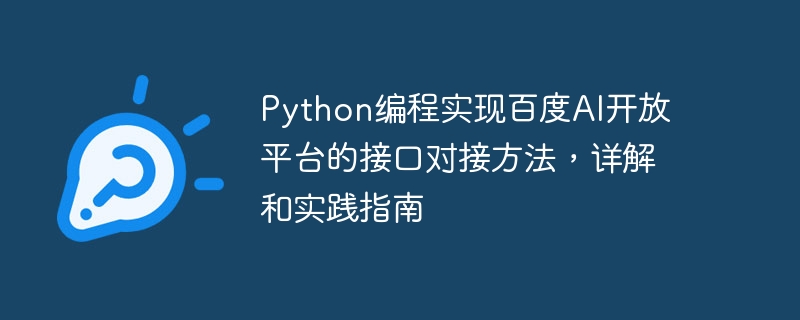ホームページ >バックエンド開発 >Python チュートリアル >Baidu AI オープン プラットフォームのインターフェイス ドッキング方法を実装するための Python プログラミング、詳細な説明と実践ガイド
Baidu AI オープン プラットフォームのインターフェイス ドッキング方法を実装するための Python プログラミング、詳細な説明と実践ガイド
- 王林オリジナル
- 2023-08-12 17:37:061398ブラウズ

Python プログラミングは、Baidu AI オープン プラットフォームのインターフェイス ドッキング メソッド、詳細な説明と実践ガイドを実装します。
-
はじめに Baidu AI オープン プラットフォームは、豊富な機能を提供します。人工知能のインテリジェント インターフェイスには、音声認識、画像認識、自然言語処理などの機能が含まれます。この記事では、Python プログラミングを通じて Baidu AI オープン プラットフォームのインターフェイスに接続する方法を詳細に説明し、実践的なコード例を示します。 -
準備 開始する前に、次の準備を完了する必要があります。 - Baidu AI オープン プラットフォームでアカウントを作成し、アプリケーションの API キーと秘密キーを取得します。
- Python のリクエスト ライブラリ リクエストをインストールします。これは pip コマンドでインストールできます。
-
インターフェイス認証 Baidu AI オープン プラットフォームのインターフェイスを使用する前に、インターフェース認証を実行する必要があります。認証 API を呼び出して access_token を取得し、その access_token をリクエスト ヘッダーのパラメーターとして使用してインターフェイスを呼び出すことができます。
pip install requests
-
インターフェイス呼び出し access_token を取得した後、Baidu AI オープン プラットフォームのインターフェイスを使用して、電話をかけます。以下では、詳細な紹介の例として音声認識インターフェイスの呼び出しを取り上げます。
import requests
# 定义鉴权API的URL
auth_url = 'https://aip.baidubce.com/oauth/2.0/token'
# 设置API Key和Secret Key
api_key = 'your_api_key'
secret_key = 'your_secret_key'
# 构造鉴权API的参数
params = {
'grant_type': 'client_credentials',
'client_id': api_key,
'client_secret': secret_key
}
# 发送http请求
response = requests.get(auth_url, params=params)
# 解析返回结果
access_token = response.json()['access_token']https://vop.baidu.com/server_api次は音声認識インターフェイスのコード例です:
-
概要 この記事では、Python プログラミングを使用して Baidu AI オープン プラットフォームのインターフェイス ドッキング メソッドを実装する方法を詳しく紹介し、認証インターフェイスと音声認識インターフェイスのサンプル コードを提供します。この記事を学ぶことで、読者は基本的なインターフェイスのドッキング方法を習得し、特定のニーズに応じて拡張して適用できるようになると思います。 Baidu AI オープン プラットフォームのインターフェイスをよりよく理解し、使用するために、読者はさらに実践し、実際のプロジェクト アプリケーションを実施することをお勧めします。
import requests
import base64
# 定义语音识别API的URL
speech_url = 'https://vop.baidu.com/server_api'
# 设置要进行语音识别的语音文件路径
audio_file = 'path/to/audio/file.wav'
# 将语音文件转换成base64编码
with open(audio_file, 'rb') as f:
speech_data = f.read()
speech_base64 = base64.b64encode(speech_data).decode('utf-8')
# 构造语音识别API的参数
params = {
'dev_pid': '1536', # 中文普通话
'cuid': 'your_cuid',
'token': access_token,
'speech': speech_base64,
'len': len(speech_data)
}
# 发送http请求
response = requests.post(speech_url, data=params, headers={'content-type': 'application/json'})
# 解析返回结果
result = response.json()以上がBaidu AI オープン プラットフォームのインターフェイス ドッキング方法を実装するための Python プログラミング、詳細な説明と実践ガイドの詳細内容です。詳細については、PHP 中国語 Web サイトの他の関連記事を参照してください。
声明:
この記事の内容はネチズンが自主的に寄稿したものであり、著作権は原著者に帰属します。このサイトは、それに相当する法的責任を負いません。盗作または侵害の疑いのあるコンテンツを見つけた場合は、admin@php.cn までご連絡ください。

